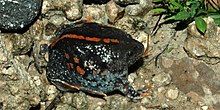Rhinophrynidae
| Rhinophrynidae | |
|---|---|

| |
| Juvenile Rhinophrynus dorsalis
| |
| Scientific classification | |
| Domain: | Eukaryota |
| Kingdom: | Animalia |
| Phylum: | Chordata |
| Class: | Amphibia |
| Order: | Anura |
| Clade: | Pipoidea |
| Family: | Rhinophrynidae Günther, 1859 |
| Type genus | |

The Rhinophrynidae are a family of frogs containing one extant genus, the
Rhinophrynus,[1][2][3][4] and a number of fossil genera.[3][5] The family is sometimes known as the Mexican burrowing toads[1] or simply burrowing toads.[2]
Rhinophrynus occurs in the Central America north from Costa Rica to Mexico and Texas.[1] Fossil finds of Rhinophrynidae come from Mexico, the United States, and Canada.[5] Rhinophrynus is a burrowing ant and termite eater.[2][4]
Systematics
The Rhinophrynidae are the
sister taxon of the Pipidae.[1] The clade formed by these two genera is sometimes referred to as Xenoanura[4] or superfamily Pipoidea.[6]
Genera
- Rhinophrynus or Mexican burrowing toad Late Eocene-Recent[7]
- †Chelomophrynus Henrici 1991 Wagon Bed Formation, Wyoming United States, Eocene
- †Eorhinophrynus Hecht 1959 Polecat Bench Formation, Wyoming, United States, Paleocene
- †Rhadinosteus Henrici 1998 Morrison Formation, Utah, United States, Late Jurassic
The affinity of Eorhinophrynus is uncertain.[3]
References
- ^ a b c d e Frost, Darrel R. (2016). "Rhinophrynidae Günther, 1859". Amphibian Species of the World: an Online Reference. Version 6.0. American Museum of Natural History. Retrieved 22 April 2016.
- ^ a b c d "Rhinophrynidae". AmphibiaWeb: Information on amphibian biology and conservation. [web application]. Berkeley, California: AmphibiaWeb. 2016. Retrieved 22 April 2016.
- ^ .
- ^ a b c Vitt, Laurie J.; Caldwell, Janalee P. (2014). Herpetology: An Introductory Biology of Amphibians and Reptiles (4th ed.). Academic Press. p. 476.
- ^ a b c "Family Rhinophrynidae (burrowing toad)". Paleobiology Database. Fossilworks. Retrieved 17 December 2021.
- JSTOR 1466954.
- ISSN 0022-1511.
